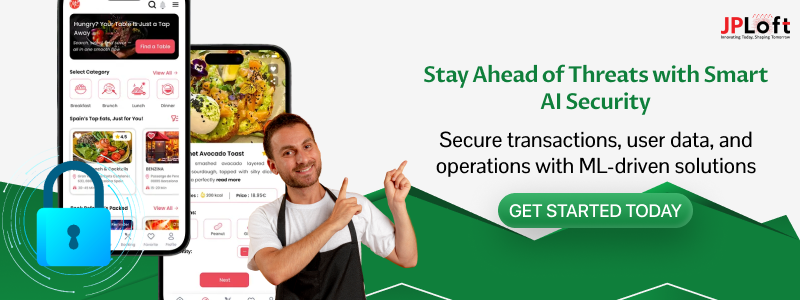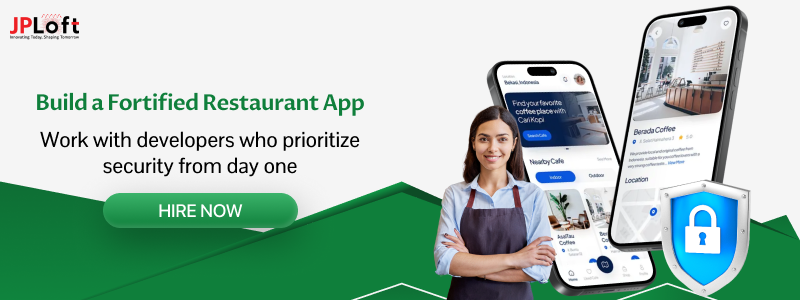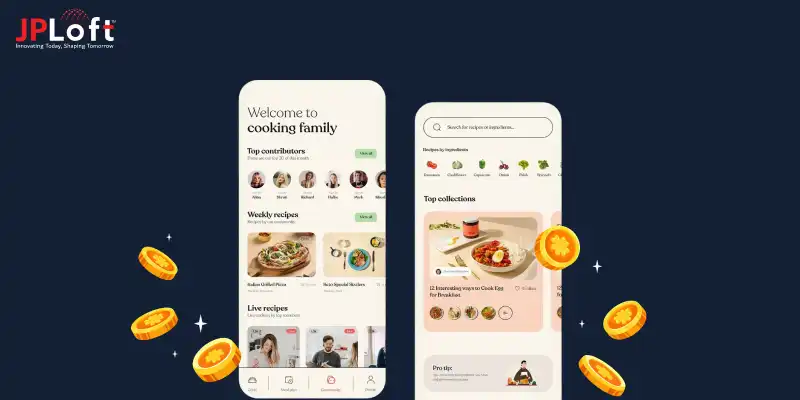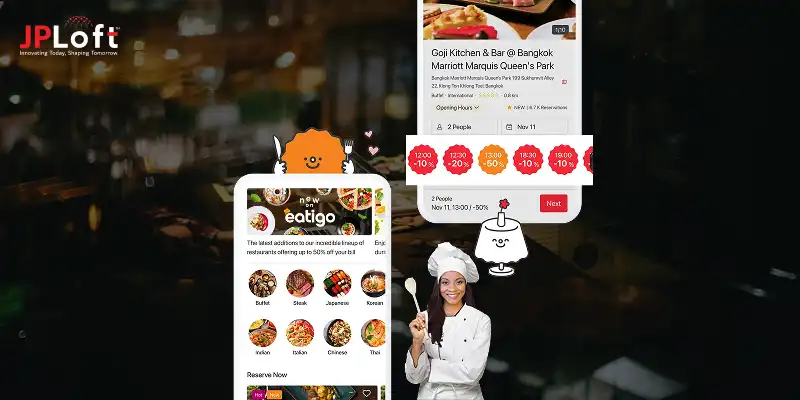Did you know? What’s more dangerous than a bad restaurant review in 2025?
A customer data breach caused by your mobile app is something far more damaging than a few stars lost on Yelp.
In a world where trust is everything, one breach can unravel your brand overnight.
Picture this: a popular restaurant chain launches a flashy new mobile app—sleek design, fast ordering, and seamless payments. But within weeks, it’s hit by a massive data breach. Customer details are leaked, payments compromised, and trust completely shattered. That’s not fiction—it’s today’s reality. And in 2025, the risks are only getting worse.
As restaurants go digital to stay competitive, their mobile apps are becoming goldmines of sensitive data—personal details, saved cards, location info, and even order behavior. While user experience and features often get top billing, restaurant app security is still too often an afterthought. And that’s a dangerous oversight.
With rising threats like payment fraud, unauthorized access, and third-party vulnerabilities, developers and restaurant owners can no longer afford to treat security as an optional upgrade. Instead, it must be built into the app’s DNA from day one.
This blog dives deep into why restaurant app security matters now more than ever, the top threats to watch out for, and how to build a secure, compliant, and future-ready restaurant app in 2025. Whether you're a founder, CTO, product manager, or tech-savvy restaurateur, this guide will give you everything you need to safeguard your digital kitchen.
Let’s break down why prioritizing security isn’t just good practice—it’s non-negotiable.
Restaurant App Usage & Cybersecurity Statistics You Should Know
The restaurant industry’s digital transformation has accelerated like never before. By 2025, the global restaurant industry is projected to reach a staggering $4.2 trillion in revenue, making it one of the largest and fastest-growing sectors worldwide. With that growth comes heightened digital adoption—and heightened risk.
In 2025, nearly every modern food business will have a mobile app—whether it’s for ordering, reservations, payments, loyalty programs, or all of the above. But behind this innovation lies a growing concern: app security.
According to Cybersecurity Ventures, the global cost of cybercrime is projected to hit $10.5 trillion annually by 2025, growing by 15% year over year. Restaurants, especially those with mobile platforms, are now prime targets due to the volume of sensitive customer data they process daily.
A 2024 report from IBM highlights that food service businesses are increasingly experiencing cyberattacks, with 183,000+ individuals impacted in a single breach involving a national chain. Even more concerning: over 60% of restaurant apps reportedly lack basic encryption protocols, leaving personal and payment information exposed.
From small cafes to large QSR chains, the threat is widespread. A breakdown by Cobalt shows:
-
90% of restaurants have experienced a data breach
-
55% of incidents involve payment/POS-related vulnerabilities
-
62% of customers worry about their data when ordering online
If you're a tech decision-maker or owner, you can't afford to overlook these numbers. It's time to ask: How to secure a restaurant mobile app from cyberattacks before it becomes your reality.
And if you’re in the early stages of digital expansion, now’s the moment to think long-term. Start by learning how to develop a restaurant app with security baked into the core architecture, not patched in as an afterthought.
Because in 2025, trust is everything, and your customers won’t stick around after a breach in restaurant app cybersecurity.
Why Restaurant App Security Is Non-Negotiable?
As mobile apps become central to how restaurants operate—handling orders, payments, loyalty, and personalization—security can no longer be an afterthought.
Whether you’re building from scratch or scaling up, protecting your data and your users is now a baseline requirement, not a competitive advantage.
Here’s why you simply can’t afford to overlook restaurant app security in 2025:
► Sensitive Customer Data Is a Goldmine for Hackers
From saved payment details to real-time location and personal preferences, restaurant apps hold a massive amount of private data. A single vulnerability can expose thousands of users, damage your reputation, and attract legal consequences. That’s why security must be part of your foundation.
► AI-Driven Personalization = More Data, More Risk
Many of the best restaurant apps now use AI in restaurant apps to deliver personalized menus, deals, and experiences. But the more behavioral data you collect, the more appealing your app becomes to cybercriminals—making restaurant app cybersecurity a top priority from day one.
► One Breach = Business & Trust Lost
Data breaches don’t just bring fines—they break customer trust. If you lose that, you lose business. Instead of waiting for damage control, focus on prevention by following the best practices to secure a restaurant app and using AI-driven threat detection and response tools early on.
► Building Security from the Start Saves Time & Cost
Adding security late in the process leads to delays, costly patches, or even rebuilds. Whether you're estimating the cost to develop a restaurant app or planning future upgrades, baking in protection from day one will save you more than just development dollars—it protects your long-term growth.
But before you secure anything, you need to understand what you're up against.
Let’s explore the top security threats facing restaurant apps—and how to fix them before they disrupt your business.
Top Security Threats Facing Restaurant Apps (And How to Fix Them)
In 2025, restaurant apps aren’t just about food—they’re handling financial transactions, customer identities, location tracking, and AI-driven personalization. That makes them rich targets for cyberattacks.
Here are the common security risks in restaurant apps and how to fix them, including the top restaurant app security practices for proactive protection.
1. Weak Authentication & Authorization
Many apps still rely on simple email-password logins without proper validation. These are vulnerable to brute-force attacks, credential stuffing, or unauthorized access using leaked credentials from other platforms.
Fix: Use multi-factor authentication (MFA), biometric options like Face ID or fingerprint unlock, and OAuth 2.0 for secure login authorization. Apply session timeout rules and monitor unusual login attempts using AI-based behavioral analysis to spot fraud in real time.
2. Unsecured APIs and Third-Party Integrations
Most of the best restaurant apps rely on third-party APIs for features like delivery, reviews, maps, and payments. But APIs are a huge attack surface. A single vulnerable endpoint can expose the entire backend.
Fix: Use encrypted communication (HTTPS), secure access tokens, input validation at both ends, and strict rate limiting. Regularly test all third-party services using automated scanners and penetration testing tools.
If you’re unsure how to secure your APIs end to end, working with a proven mobile app development company in Denver or a security-focused tech partner can bring best practices, secure API architecture, and vulnerability testing into your workflow from the beginning.
3. Lack of Data Encryption
If user data like payment details, addresses, or saved preferences is stored or transmitted in plaintext, it can be intercepted or stolen with minimal effort.
Fix: Implement SSL/TLS for data in transit and AES-256 encryption for data at rest. Avoid storing sensitive information unless necessary, and use tokenization for payment processing. Regularly audit storage policies for compliance.
4. Inadequate Input Validation
Apps that fail to properly sanitize user inputs are at risk of SQL injection, cross-site scripting (XSS), and command injection attacks, especially during signups, searches, and form submissions.
Fix: Use strict input validation, apply whitelisting (instead of blacklisting), and implement parameterized queries. Conduct regular code audits and security reviews to catch flaws early in the development lifecycle.
5. Lack of Real-Time Threat Detection
Traditional firewalls and static security tools can’t catch modern threats like credential stuffing or bot attacks that evolve in real time.
Fix: Integrate machine learning models that monitor user behavior continuously and trigger alerts for unusual activity, like rapid-fire login attempts or location mismatches. Pair it with NLP-powered filters for chatbots to detect phishing or manipulation attempts.
6. Overly Permissive User Roles
When staff or users have more access than necessary—like admins with database rights or delivery partners accessing customer data—it increases breach damage.
Fix: Apply the principle of least privilege (PoLP). Create clear user role hierarchies and limit access based on job function. Use role-based access control (RBAC) enforced through policy engines.
7. Poor Session Management
Sessions that don’t expire properly or allow session reuse can be hijacked, letting attackers impersonate legitimate users.
Fix: Use short session timeouts, secure cookies (with HttpOnly and Secure flags), and force re-authentication before sensitive operations like profile changes or payments.
8. Unsecured Chatbots for Customer Support Forms
AI-powered support tools are great, but if your chatbot or contact form allows unvalidated input, it’s a door to injection or phishing-style attacks.
Fix: Use NLP-aware sanitization filters that detect malicious intent in text fields. Avoid accepting HTML or JavaScript inputs, and log all support interactions for audit trails.
9. Lack of Code Obfuscation or Binary Protection
Attackers can reverse-engineer app binaries to uncover vulnerabilities, especially in Android APKs, which are easier to unpack.
Fix: Use code obfuscation tools, disable debug builds in production, and sign builds with secure certificates. Perform security testing on the compiled app, not just the source code.
10. Insecure Update Mechanisms
If your app update process isn’t protected, attackers could push a malicious version or tamper with the package.
Fix: Always use encrypted and signed updates via trusted platforms (like Google Play or App Store). Add update version checks and integrity verification in the app logic.
Cyberattacks aren’t slowing down, and prevention is no longer a “nice to have”.
Embedding the top restaurant app security practices into your development lifecycle is the only way to stay competitive, compliant, and trusted.
Security is no longer optional. It’s the expectation.
But awareness alone isn’t enough. You need a clear, actionable framework to move from good intentions to real-world protection.
How to Integrate Security in Developing Restaurant App Cycle?
Security isn’t a plug-in. It’s a mindset that needs to be baked into every phase of the software development lifecycle (SDLC).
The earlier you integrate it, the cheaper, smoother, and more effective it is. This is what makes secure development of restaurant apps not just ideal, but necessary.
Here’s how to do it right, using a shift-left approach and tools that streamline security without slowing innovation.
These are also essential steps to integrate security in a restaurant delivery app, especially when customer data, transactions, and location tracking are involved.
1] Start with Secure Planning
Before writing a line of code, outline security goals: What user data will you collect? Who has access? What regulations do you need to follow? This forms the foundation for threat modeling, risk analysis, and compliance checks.
Proactive planning aligns with current restaurant app development trends, where privacy-first architecture is now a product differentiator, not a backend detail.
2] Implement Secure Coding Standards
During development, your team should follow OWASP Mobile Top 10 guidelines. That means writing secure APIs, using proper data encryption, and applying validation on both client and server sides.
Leverage AI development services for code scanning to catch insecure logic early and ML development services to implement QA tools that flag anomalies before release.
These services can dramatically reduce time-to-detect and improve overall code hygiene at scale.
3] Integrate Security Testing Throughout
Don’t wait for the QA phase. Use SAST (Static Application Security Testing) tools while coding, DAST (Dynamic Application Security Testing) in staging, and vulnerability scans before release.
Some NLP-based tools can even review chatbot scripts and voice commands to detect linguistic manipulation, which is key for apps using AI ordering assistants.
4] Monitor Post-Deployment Behavior
Even after your app launches, continue security checks using behavior analysis tools. Real-time anomaly detection via machine learning helps prevent threats from evolving under the radar.
A true guide to secure a restaurant app is incomplete without continuous monitoring, updates, and DevSecOps culture across teams.
So, before you calculate the cost to build a restaurant reservation app like OpenTable, make sure your blueprint includes security checkpoints in every sprint. A delayed feature can be forgiven. A leaked credit card? Not so much.
Leveraging AI and ML to Enhance Restaurant App Security
Traditional security tools are reactive. They rely on pre-written rules and signatures—great for yesterday’s threats, not tomorrow’s.
Enter modern app security for restaurants, powered by AI, ML, and NLP—a game-changer in proactive, intelligent protection.
So, how can AI improve restaurant app security features in 2025? Let’s explore five key applications:
1. Real-Time Behavioral Threat Detection
AI doesn’t just spot known threats; it learns what “normal” looks like for each user.
So when a login happens from an unusual location or a device behaves erratically, the system can detect and block it in milliseconds—no human intervention needed.
Think of it as your 24/7 digital bouncer.
2. ML-Driven Transaction Monitoring
Whether it’s a sudden spike in refund requests or abnormal tip amounts, machine learning models can flag suspicious financial behaviors.
This helps prevent payment fraud, account takeovers, and loyalty point abuse. The best part? The more data it sees, the smarter it gets.
3. NLP-Powered Chatbot and Voice Security
Chatbots and voice assistants have become key engagement tools in restaurant apps. But they’re also a weak point if not secured.
NLP can analyze messages in real time to detect phishing language, manipulation patterns, or attempts to extract personal information, protecting both your support agents and your users.
4. Automated Incident Response
When an attack is detected, time is everything. AI helps by instantly responding—locking accounts, triggering alerts, updating firewalls, or forcing logouts.
This automated security orchestration minimizes human error and shrinks reaction time from hours to seconds.
5. Predictive Vulnerability Analysis
Going beyond real-time protection, AI can also predict where attacks might happen next. By analyzing past attack trends, user patterns, and code repositories, AI engines can proactively warn developers about weak spots in the app before they’re exploited.
By embedding AI in restaurant app security, developers can stay ahead of evolving threats while reducing manual workload. And with features like NLP filters, fraud prevention, and predictive analytics, AI isn’t just supporting your app—it’s actively defending it.
These innovations directly tackle many restaurant app development challenges that traditional testing and monitoring can’t keep up with.
Best Practices for Restaurant App Security in 2025
The cybersecurity game is evolving rapidly, and so are the attack vectors targeting restaurant apps.
Whether you’re building from scratch or scaling an existing platform, following the best restaurant app security practices in 2025 isn’t optional—it’s mission-critical.
Here’s a restaurant app security guide to help you follow not just strong practices but smart ones that work with your tech stack, user behavior, and AI-driven tools.
This is what defines mode app security for restaurants—a comprehensive, adaptive approach that merges policy, technology, and user-first design.
A] Embrace a Zero-Trust Security Model
In this model, nothing—no device, user, or connection—is trusted by default. Enforce authentication and access control at every layer, not just login.
This ensures compromised credentials alone aren’t enough to breach your system.
B] Secure the Core: APIs, Data & Servers
Use token-based API authentication (like OAuth 2.0), encrypt all sensitive data (at rest and in transit), and ensure your cloud servers follow role-based access control (RBAC).
These are no longer optional—they’re foundational to the top restaurant app security practices.
C] Apply AI & Automation for Threat Response
As threats get more sophisticated, so should your defence. AI and ML-based tools can help you monitor user behavior, detect anomalies, and even auto-isolate threats.
This is where AI in restaurant apps goes beyond customer service—it’s now a core part of your security ecosystem.
D] Keep Software & SDKs Updated
Outdated libraries and third-party SDKs are among the most exploited vulnerabilities.
Automate update reminders and version control in your CI/CD pipeline to stay secure without slowing your release cycles.
E] Train Teams & Hire Smart
Even the strongest code can’t save you from human error. Conduct regular security training for developers, product managers, and support teams.
Better yet, hire dedicated developers with experience in secure mobile app architecture who follow security-first coding protocols from day one.
F] Design Security Around UX
Many brands lose users by making login and checkout processes painful in the name of security. Instead,
Implement biometric logins, token-based payments, and invisible fraud detection to ensure a seamless but safe experience. These strategies align closely with the top restaurant app features that users now expect.
Following the best practices to secure a restaurant app in 2025 means embedding security not just in code, but across people, policies, and platforms. The best apps are secure by design, not as an afterthought.
Restaurant App Compliance — GDPR, PCI-DSS & Local Laws
Security is only one side of the coin. The other? Compliance—and in 2025, it’s tighter, more complex, and strictly enforced.
If you’re collecting customer data (and you almost certainly are), you need to ensure full restaurant app data privacy compliance with global and regional laws.
Let’s break down what that looks like—and how to stay ahead of audits, penalties, and reputation damage.
1. GDPR: Protecting EU Citizens, Wherever They Are
The General Data Protection Regulation (GDPR) applies to any app that handles EU user data, regardless of your business location. It mandates:
-
Transparent data policies
-
User consent before collecting personal data
-
The right to be forgotten (data deletion)
-
Strict breach notification requirements
Even if your app is focused on U.S. diners, a traveler from France placing an order could bring you under GDPR scrutiny. Ask yourself: Is my restaurant app compliant with data protection laws? If the answer isn’t a clear yes, it’s time to act.
2. PCI-DSS: Payment Security Is Non-Negotiable
If your app processes card payments, you’re subject to PCI-DSS regulations. This includes encrypting credit card data, regular security testing, access controls, and maintaining an incident response plan.
AI tools now help automate PCI-DSS audits, flag unusual payment behavior, and secure payment APIs using tokenization—all essential for restaurant app cybersecurity.
3. Local Laws & Industry Regulations
Beyond global frameworks, countries like India (DPDP Act), the U.S. (CCPA), and Canada (PIPEDA) have their own privacy rules.
These can affect how you store, transfer, and process user data across regions.
If you’re exploring fresh restaurant app ideas across international markets, build multi-regulatory compliance into your architecture from the start.
4. AI + NLP for Automated Compliance Monitoring
Many modern compliance tools now use AI and NLP to read through policies, map them against your app’s permissions, and flag violations before a breach occurs.
This is where investing in NLP development services can help automate policy audits, consent flows, and even customer support FAQs related to data rights.
5. Why Compliance Matters for Revenue, Too
It’s not just about avoiding fines. Privacy-compliant apps build user trust, and trust drives conversion. The more secure your platform feels, the more orders and repeat business it earns.
So if you're wondering how restaurant apps make money sustainably, a big part of the answer lies in creating a platform that’s privacy-conscious by design.
Compliance isn’t a checklist—it’s a continuous process that evolves as new laws and threats emerge. Aligning your roadmap with restaurant app data privacy compliance will help you grow without legal roadblocks.
How JPLoft Implements Security-First Restaurant App Development?
At JPLoft, secure development of restaurant apps isn’t an afterthought—it’s embedded in every line of code, every feature, and every deployment cycle.
From the discovery phase, we work closely with clients to conduct risk assessments, define security policies, and outline compliance goals, ensuring that your app is both functional and fortified. Our dev team integrates:
-
End-to-end data encryption
-
Secure third-party integrations
-
Role-based access control
-
Biometric and multifactor authentication
-
Compliance-ready architecture (GDPR, PCI-DSS, HIPAA, and more)
We also use AI-powered vulnerability scanning tools and CI/CD pipelines to spot risks early and fix them before they reach production.
If you’re looking for a restaurant app development company that takes both innovation and security seriously, JPLoft brings you the perfect balance, so you can scale with confidence, not compromise.
Final Thoughts
In 2025, great food alone won’t earn customer loyalty—trust and security will. As restaurant apps continue to grow in scale and sophistication, so do the threats targeting them. Ignoring this reality means leaving your users, your brand, and your revenue exposed.
This isn’t just about ticking boxes on a compliance form. It’s about proactive protection, using everything from AI and ML to biometric logins, encryption, real-time threat detection, and automated compliance systems.
Whether you're building a new platform or scaling an existing one, developing restaurant app is non-negotiable. Following the top restaurant app security practices, adopting modern tools, and staying aligned with frameworks like GDPR and PCI-DSS are now essential, not optional.
Security done right becomes a business advantage. So the real question isn't “Can I afford to invest in security?”—it's “Can I afford not to?”
FAQs
Because threats have evolved just as fast as technology. With more restaurant apps handling sensitive customer data, digital payments, AI chatbots, and third-party integrations, the attack surface is broader than ever. In 2025, restaurant app security isn’t just about protecting data—it’s about protecting your brand’s trust, legal standing, and revenue streams.
The biggest threats include weak authentication, insecure APIs, unencrypted payment data, and outdated third-party SDKs. Hackers often exploit these gaps to steal user information, inject malware, or commit payment fraud. That’s why following the best practices to secure a restaurant app is vital during development and post-launch maintenance.
Start by aligning your app with major compliance frameworks like GDPR, PCI-DSS, and local laws (like CCPA or India’s DPDP Act). This includes gaining explicit user consent, securing payment data, enabling easy data deletion, and having a documented breach response plan. A restaurant app security guide can help you align all these components systematically.
Absolutely. In 2025, AI in restaurant app security is more than a trend—it’s a necessity. AI and ML tools can detect threats in real time, block suspicious behavior, predict vulnerabilities before they’re exploited, and even automate compliance checks. These tools dramatically reduce human error and increase response speed.
Yes—especially now. Neglecting security in early builds can lead to data breaches, compliance violations, or reputational damage right out of the gate. Security should be baked into the architecture from day one, even if you're launching a lean MVP. Tools like code-level encryption and secure APIs are now MVP essentials, not post-launch upgrades.













Share this blog